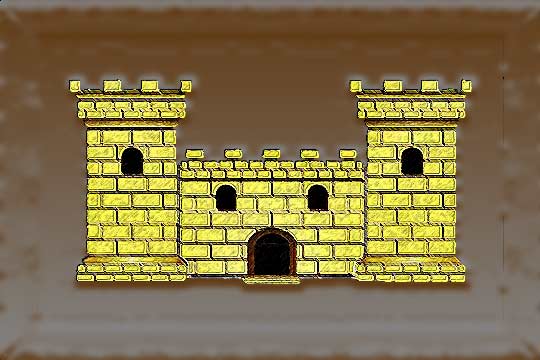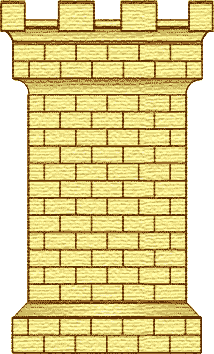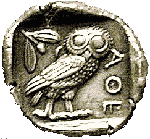Thermisia, Ermionida, Argolis,Peloponnese
Thermisi
| Location: |
| On a rocky hill north of Thermisia, Ermionis, Peloponnese |
| Region > Prefecture: |  |
| Peloponnese Argolis | |
| Municipality > Town: | |
| City of Ermionida • Thermisia | |
| Altitude: | |
| Elevation ≈ 230 m |
| Time of Construction | Origin | |
| early 14th cent. | FRANKISH |
|
| Castle Type | Condition | |
| Castle |
Rather Poor
|
A byzantine castle in Ermionis that was used mainly by the Venetians.
The Name of the Castle
The castle takes its name from the ancient temple of Demeter Thermasia that was nearby, at the lagoon, not on the rock (Pausanias II).
History
It is not known when exactly the castle was built. The only thing we are certain of is that it was built before 1347, as it is mentioned in the will of the ruler of Argolis, Gautier VI de Brienne (see below). Therefore, it is either Frankish (built in the 13th-early 14th century) or Byzantine (built before the 13th century).
The only indication of a Byzantine presence in the castle are the few ruins of a church that maybe belongs to the Middle Byzantine Period. However, this is not enough to characterize it as a Byzantine castle and there is no indication that it is a 12th century construction, as we previously believed.
The most likely period of construction of the castle is considered to be the 1320s. This was the time when the Byzantines of Mystras began to advance northward and gain territory from the Franks. It is possible that, because of this threat, the Franks of Argolis decided to build two new castles: Kiveri and Thermisi.
Other reasons (apart from the growing Byzantine threat) that support this hypothesis are that 1) these two castles belonged to De Brienne and are mentioned in his will (as Chamires and Trémis respectively), dated 18 June 1347, 2) the castles did not pre-exist since the Middle Byzantine Period, otherwise they would definitely be mentioned in the story of the Frankish conquest (given that they were strong castles), 3) the construction style does not at all resemble older Frankish fortifications of the Duchy of Athens, of the De la Rosche era (i.e. the 13th century).
In conclusion, the castle at Thermisi is probably Frankish and certainly built before 1347, with many chances of dating to the 3rd decade of the 14th century.
The first official mention of the castle's existence is in 1347, in the will of Gautier VI de Brienne, who was titular Duke of Athens (Athens was actually in the hands of the Catalans) and lord of Argos and Nafplio (but he probably never set foot in Argolis, where his representatives, Gautier, and after 1324, Nicolo Fourcherolles, exercised power).
In 1356 the castle, along with the rest of Argolis, passed into the hands of the De Brienne descendant Isabelle d’Enghien, who was the legal heiress of the De la Roche and of De Brienne houses.
Among the Duchess’s possessions is mentioned the Castle of La Tremis. This is apparently the castle of Thermisia.
In 1377, Argolis was inherited by Maria d’Enghien, Isabella’s granddaughter. Maria married Peter Cornaro, a Venetian from Nafplio, who wanted to bring the duchy under Venice. The Venetians approved this, but in the meantime Cornaro died. Venice eventually purchased Argolis from his widow in 1388 for 700 gold ducats per year for life.
Before the Venetians could settle there, it was seized by the Byzantines of the Despotate of Mystras (along with Argos and Kiveri). The protagonist of this seizure was the despot of Mystras, Theodore I Palaiologos, assisted by accidental allies: the Florentine Duke of Athens Nerio Accuaolli and the Turkish Evrenos Pasha. The Byzantines held these castles until 1394, when they finally returned them to the Venetians.
Thermisi was also included, which remained Venetian for the next century and a half. The agreement was that the castles would be occupied by the Venetians, recognizing the sovereignty of the Despotate. This term ceased to apply in 1411.
The First Venetian Rule in Argolis covered the period 1394-1537. The Second Venetian Rule was shorter: 1689-1715. In the Ermionida region, the Venetian administrative center was Thermisi.
When the Turks conquered the Peloponnese in 1460, Argolis remained Venetian. The same happened after the First Venetian-Turkish War (1463-1479). The Venetians, with the treaty of 1479, kept some castles, and Thermisi was among them.
Throughout this period of Venetian presence, the castle must have received upgrades and reinforcements from the Venetians. That is why the few ruins that survive from the castle today are more reminiscent of a Venetian than a Frankish castle.
A report by the captain of Nafplio Nikolaos Gyoustianis from 1525 states that the castle is so secure that two (!) people were enough to guard it: the guard Francesco Boldu and the knight Ieronymos, who had been appointed to this position for 100 years! This exaggerated story may be indicative of the strength of the castle, but it may also mean that the castle was no longer very important to the Venetians.
It is noteworthy that the castle is not mentioned in the various lists (by Hopf etc.) of the 14th and 15th centuries with the Latin castles in the Peloponnese. The same applies to the other castle founded at the same time in Argolis, the castle of Lerna in Kiveri. For the lists of the years 1391, 1463, 1467 this is expected, because these two castles had now become, based on treaties, Venetian possessions without any dispute. However, its absence from the list of 1377 – before the annexation to Venice – is inexplicable, because this list includes the castles of Argos and Nafplio. A possible explanation is that at that time these castles had some special ownership status that did not allow them to be considered as belonging to the Principality of Achaia.
The castle fell into the hands of the Turks in 1537, during the Third Venetian-Turkish War.
The legend of the “Oria” (beautiful lady) that fell from the rock probably dates back to this conquest.
The Ottomans, after the first occupation, in the 16th century, made some repairs and used the castle.
The Venetians returned in 1686 after their victory in the Sixth Venetian-Turkish War, when they became masters of the entire Peloponnese. In this second period, the Venetians did not repair the castle and perhaps did not man it. The Second Venetian Rule ended in 1715. Before finally abandoning the area, the Venetians blew up and destroyed the castle of Thermisi so that it would not be used by the Ottomans.
Thus, the castle was never used again after 1715.
Structure, Fortification & Buildings
The castle was built on two rocks 3 km north of the village Thermisi. There is a third smaller rock nearby which was not fortified.
Few ruins remain from the castle since it was destroyed by the Venetians when they left in 1715.
The western rock
The western summit (A in Layout ) falls away in sheer cliffs on the west. It slopes down more gently towards the saddle, and from there spreads south to form a broad sloping triangle, limited at its southern edge by a cliff. This whole area constitutes the ward or bailey, and is filled with the foundations of collapsed buildings. It is fortified to the north and west only. No traces were found of the entrance to the complex, which must have been from the north, by way of the saddle, either just at the foot of the redoubtor further west.
The eastern rockThe eastern summit (B in Layout), an isolated massif which is now inaccessible from the west, served as the redoubt. It is an elongated plateau,about 90 m. by 30 m., with sheer thirty-meter cliffs on the west, even higher cliffs on the south. Most of the southern side of this massif is unfortified.
The other three sides, which are slightly more accessible, are protected by walls. There are traces of a staircase which led down to the saddle. There are also the remains, near the northeast corner, of what must have been a pulley-entrance. A few buildings can be seen in the redoubt: a cistern against the east wall, a tower (about 6.10 m. by 5.20 m.) at the highest point of the fort, and a Byzantine chapel which may be as old as the 11th or 12th century.
Outside the enclosure on the long low rocky eastern spur are the ruins of a few buildings,notably another chapel.
Construction elementsThe builders of the castle exploited the strong natural situation. Walls were not built above the sheer cliffs; nowhere is the thickness of the walls much more than 0.80.m. The masonry is roughly coursed rubble, held together with a hard gritty mortar which is often lavishly applied. Larger stones are used at the corners of the wall. In several places one may observe horizontal tie beams. Where the interior height of the wall exceeds two meters, there is a narrow chemin de ronde; this was noted in the north wall of the bailey and the east wall of the redoubt (above the cistern). The whole wall of the redoubt with the exception of the western salient (which looks down into the ward) was crenelated,with notched merlons.
Elsewhere in the redoubt and throughout the bailey the walls have plain flat or
rounded tops.
There was a second building period, similar in technique to the first. The height of a western outwork was increased; and the embrasures in the crenelated east wall were filled, leaving only meurtrieres. There is no evidence of reworking for the convenience of artillery.
The notched merlons which play such a prominent role in Thermisi are characteristically Italian, and appear in Venetian colonies in Greece during the fifteenth century.Apparently then the present remains of the fort can be assigned to the first period of Venetian rule (1394-1537). There is no recognizable trace of the Frankish fortification which preceded. The Turkish occupation (1537-1686) provided only the minimum repairs and alterations necessary to maintain the castle in serviceable condition; perhaps to this period belong the alterations to the western outwork and to the east wall. Thermisi was not among the castles of the Morea which were reconditioned in the second Venetian period (1686-1715).
| First entry in Kastrologos: | November 2012 | Last update of info and text: | March 2025 | Last addition of photo/video: | March 2025 |
Sources
- Website Ιστορική Ερμιονίδα - Καστρο της Ωρηας στην Θερμησια (Greek only)
- Wallace E. McLeod, Hesperia: The Journal of the American School of Classical Studies at Athens, Volume 31, Issue 4, “KIVERI AND THERMISI”, 1962
- Φωτογραφίες 3, 4, 5, 10, 12, 20-25 έστειλε ο Δημήτριος Περσέας Λουκίσσας και πληροφορίες από το βιβλίο του «ΑΡΓΟΛΙΔΑΣ-ΚΟΡΙΝΘΙΑΣ ΠΕΡΙΗΓΗΣΙΣ - Ένα σύγχρονο οδοιπορικό στη γη των Μύθων και της Ιστορίας», Τόμος Δ’, Ανοιχτή Πόλη, Αθήνα 2024, σελ. 63-72
- Video by the user haanity Το 'Κάστρο των Μετεώρων', στη Θερμησία Ερμιονίδας | Thermisia Castle Greece Drone (photos 2, 17, 18 – 2016)
- Ιωάννης Ε. Πέππας, «Μεσαιωνικές σελίδες της Αργολίδος, Αρκαδίας, Κορινθίας, Αττικής», Αθήνα 1990 σελ. 297-298.
- Ιωάννης Θ. Σφηκόπουλος, «Τα Μεσαιωνικά κάστρα του Μορηά», Αθήνα,1968, σελ. 113-114
- Antoine Bon, La Morée franque. Recherches historiques, topographiques et archéologiques sur la principauté d'Achaïe (1205-1430), Editions de Boccard, Paris, 1969, vol I, pp. 275, 495, 658
|
|
| Access |
|---|
| Approach to the monument: |
| The rocks are 3km north of the village Thermisi. In the NE side there is a difficult path that leads to the castle |
| Entrance: |
| Free entrance |


























